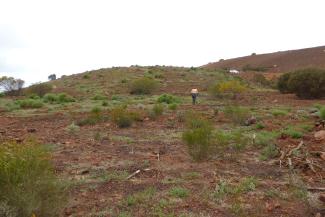Restoring ecosystems
Our research isn’t just about plants, but about their environment as well! Some of our programs focus on ways to effectively restore environments so they can support plants once more. Restoration, translocation and considerations around climate change are all vital to ecological restoration.
An important part of the puzzle for plant species’ survival is providing solutions in on-ground environmental restoration activities. This allows plants to return to their original environment, which has been restored to its natural state as closely as possible.
There are many opportunities to increase the biodiversity values of our landscapes through restoration. Better biodiversity means a healthier and more sustainable landscape, now and into the future.
Kings Park Science works to champion biodiversity conservation in a few ways, including protection of intact habitat and the restoration of degraded lands across natural, urban, agricultural and mining landscapes. These projects support on-ground restoration activities, with a focus on the most efficient and cost-effective ways to do this at the scale required.
Did you know?
Through long term collaborations, Kings Park Science has supported up to 80% of species return in post-mining landscapes.
Work in seagrass restoration has found it takes five years to form dense seagrass meadows, and 10 years to restore biodiversity and sequester carbon similar to a natural undisturbed meadow.
Topsoil is a living layer approximately 5-10cm deep and it contains the building blocks to effective restoration - seeds, microbes, fungi and nutrients!
For every dollar spent on restoration, between three and seventy-five dollars of economic benefits from ecosystem goods and services can be expected.
Restoration and conservation: a recipe for success
Kings Park Science considers many elements when researching and formulating the best plan for ecological restoration. These critical elements include understanding the establishment and survival requirements of each species, the influence of landform and landscape context, the impact of seasonal conditions and what amelioration techniques can be implemented to achieve restoration. Incorporation of these elements help us achieve the following restoration and conservation outcomes:
Restoring vegetation communities
Tackling the challenge of reconstructing biodiverse vegetation communities requires an understanding of many species that have different strategies to recruitment, growth and survival.
Translocating threatened plants
Translocations are an intensive conservation action aimed to establish or maintain self-sustaining populations to conserve threatened species and are used when alternate conservation actions have been exhausted. Kings Park works with partners to conduct experimental translocations on rare species across our state.
Ensuring the functionality of plants and restored ecosystems
Sustainability, resilience, and integration with the surrounding landscape are attributes of successful restoration programs and can be assessed by measuring key ecological functions at plant or ecosystem levels.
Considering the impact of climate change on restoration
Climate change adds to the complexity of restoration planning because it influences environmental conditions, such as temperature extremes or water availability, essential to plant establishment. In addressing climate change, predictive sourcing of seed or interventions that improve soil-water availability in a drying climate are being investigated.
